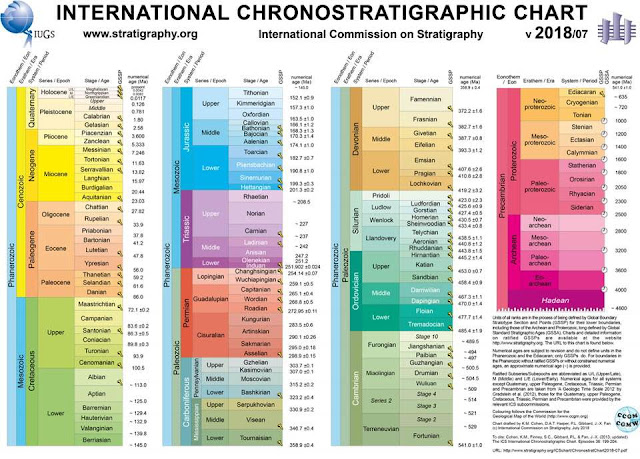Blog
The Meghalayan era: New geological era has been invented
Monday, July 23, 2018
We Are Now Living in a New Geologic Age: Meghalayan era
We’re Now Living In A New Historical Era That’s Named After An Indian State, The Meghalayan Age. This new chapter in the Earth's geology. Experts said to have begun some 4,250 years ago, and is being called the "Meghalayan Age".
 |
| A portion of an Indian stalagmite that defines the beginning of the Meghalayan Age. Image: IUGS webiste |
➽ What is the Meghalayan Age?
Geologists divide up the Earth's existence into slices of time and have classified a distinct age in Earth's history, and they're calling it the Meghalayan Age. This age, dubbed the Meghalayan, began 4,250 years ago when what was probably a planetwide drought struck Earth, according to the International Union of Geological Sciences (IUGS).
➽ Which is the 'slice' that we live in?
We currently live in what is called the Holocene, which reflects everything that has happened over the past 11,700 years. Further, the Holocene is subdivided into three parts. The Meghalayan is just one of three newly named ages, the IUGS said in an announcement released July 13. According to IUGS three parts are-
1. The Greenlandian,
2. The Northgrippian, and the youngest addition,
.3 The Meghalayan.
The Greenlandian runs from 11,700 to 8,200 years ago; the Northgrippan runs from 8,200 to 4,200 years ago, and finally, the Meghalayan runs from 4,200 years ago to present.
Geologists have systematically divided up, and named, all of Earth's roughly 4.54-billion-year history .From the longest to shortest, these lengths of time are known as eons, eras, periods and ages. Currently, we're in the Phanerozoic eon, Cenozoic era, Quaternary period, Holocene epoch and (as mentioned) the Meghalayan age.
➽ Is it True News?
Yes, The IUGS shared an image of the newly named ages in a tweet. They had tweeted about the newly named age via an image of the chart. However, they later issued a correction about the Meghalayan time period. That age goes to the present time and not up to 1950 that they tweeted out by mistake.The official version of the newly updated International Chronostratigraphic Chart can be viewed here.
The latest version of the International Chronostratigraphic Chart/Geologic Time Scale is now available! New #Holocene subdivisions: #Greenlandian (11,700 yr b2k)#Northgrippian (8326 yr b2k)#Meghalayan (4200 yr before 1950) https://t.co/IhvZHfHnWh#ChronostratigraphicChart208 pic.twitter.com/8Pf9Dnct7h— IUGS (@theIUGS) July 13, 2018
➽ What is a geological age, and how is it calculated?
An age earlier than the postglacial and hence datable only by geology. Yet in school kids are taught that Earth is 4.6 billion years old and that dinosaurs disappeared about 65 million years ago and so on. So how do scientists really identify these ages?
They do it by something called geologic age dating, where they assign an age to a material, like a rock, and then calculate the history of the earth by relating it to time, along with with major event in the Earth's past, such as the break-up of continents, dramatic shifts in climate and more.
➽ What is the material that the geologists found?
It's a rock! To determine the beginning time for each age, scientists looked at the unique chemical signatures found in rock samples from that time; each signature relates to a big climatic event.
Geologists chose the name "Meghalayan" as a nod to a rock sample they analyzed from Meghalaya, a northeastern state in India, whose name means "the abode of clouds" in Sanskrit.
➽ Facts-
the Meghalayan (also called the "upper Holocene") started 4,250 years ago, when a mega-drought devastated civilizations across the world, including those in Egypt, Greece, Syria, Palestine, Mesopotamia, the Indus Valley and the Yangtze River Valley, the BBC reported. This drought lasted 200 years and was likely prompted by shifts in ocean and atmospheric circulation.
By analyzing a stalagmite growing on the ground of Mawmluh Cave, geologists found that each of the stalagmite layers had different levels of oxygen isotopes, or versions of oxygen with different numbers of neutrons. This change marked the weakening of monsoon conditions from that time, the BBC reported.
BBC Told- "The isotopic shift reflects a 20 [percent to] 30 percent decrease in monsoon rainfall," Mike Walker, a professor emeritus of quaternary science at the University of Wales in the United Kingdom, who led the naming of the ages.
➽ Why Meghalayan Era is Unique ?
The Meghalayan is unique because it is the first interval in Earth's geological history that coincided with a major cultural event, as agricultural societies struggled to recover the shift in climate, said Stanley Finney, secretary general of the International Union of Geological Sciences (IUGS).
➽ Debate around the Meghalayan era-
Currently, there is still an active debate about assigning a new geologic slice of time, other than Holocene, and is being referred to as the Anthropocene.Mark Maslin is a professor of geography at University College London, told the BBC, "It's official, we're in a new age; who knew?" mocking the abrupt imposition of the era.
Sources-
www.livescience.com
https://www.firstpost.com
Sources-
www.livescience.com
https://www.firstpost.com
Previous article
Next article


